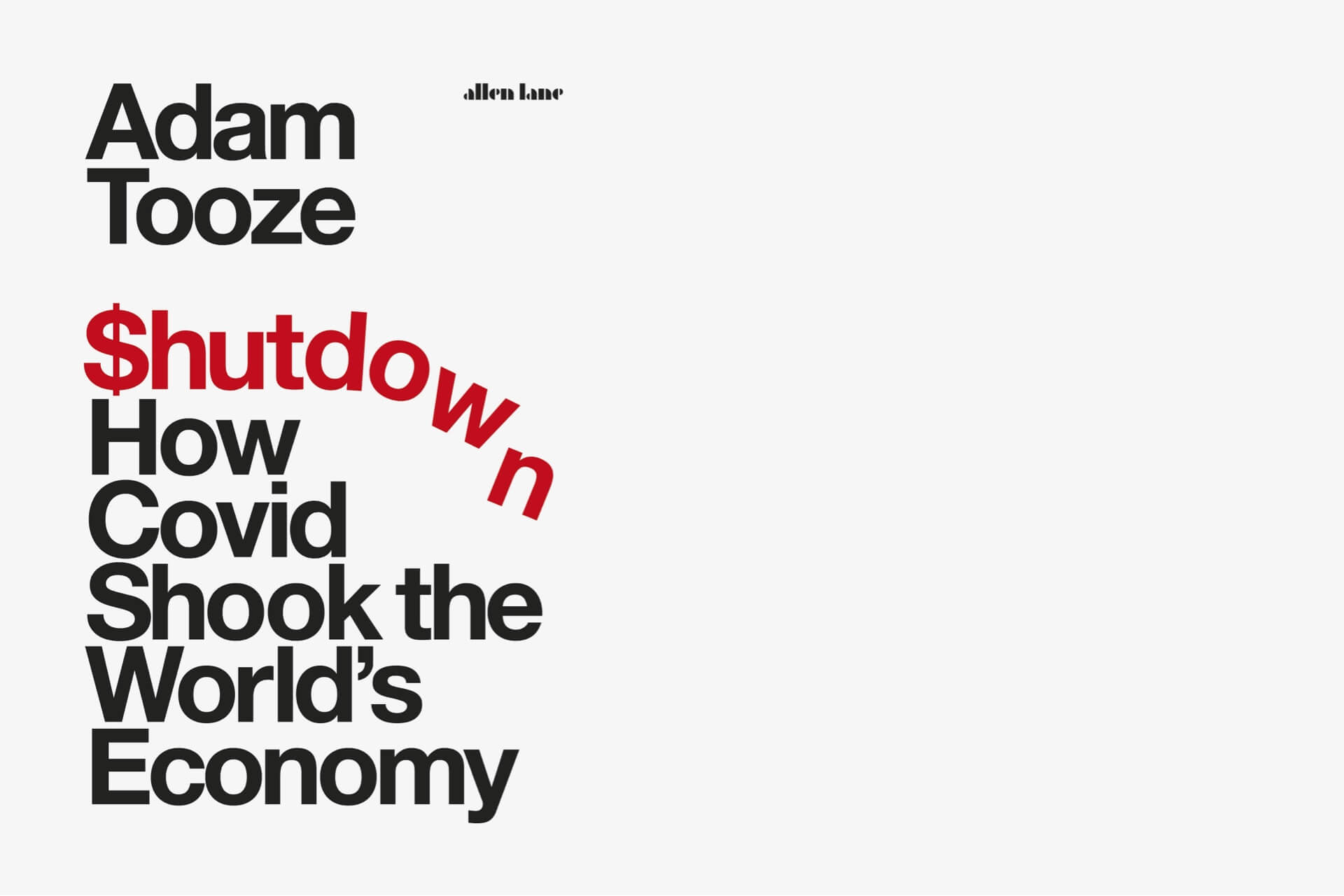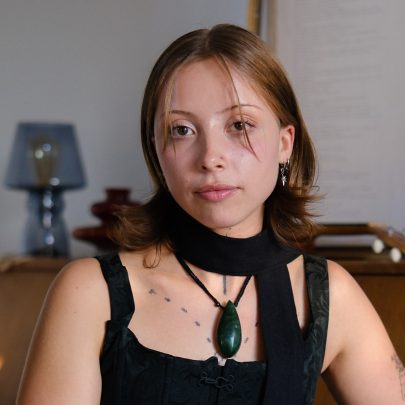Feb 21, 2022 Books
In 2020, as Covid-19 swept across Chile, the artist collective Delight Lab beamed the word HAMBRE (‘HUNGER’) in block capitals onto the side of the Telefonica tower in Santiago. Chile was the first country in Latin America to sell off its public telecommunications sector, with Telefonica now one of its leading companies. Chile was also one of the countries in Latin America most deeply affected by Covid-19, having entered the pandemic after mass social unrest in October 2019 over rising inequality.
A day later, the artist collective tried to project the words ‘HUMANIDAD’ (‘HUMANITY’) onto the same Telefonica tower. An industrial truck, positioned on the side of the road and reportedly backed by Chilean police, used six floodlights to cover up the words.
Historian Adam Tooze refers to this incident in his latest book, Shutdown, an account of the first year in which the world was gripped by Covid-19: from 20 January 2020, when Xi Jinping acknowledged an outbreak in China, to President Joe Biden’s inauguration on 20 January 2021. Shutdown focuses on the economic dimensions of Covid-19. It lays out what Covid-19 has done to economies and society the world over, how governments and businesses responded, and what all this means for economic and political systems, with a particular focus on the United States, China and the European Union.
The Chilean story is a neat illustration of some of the themes of the book: how Covid-19 has highlighted problems of the pro-market economic and political order that has been dominant since the 1970s and 1980s, how Covid-19 has exacerbated pre-existing inequality, and how governments have often been indifferent to that inequality.
Shutdown begins with the initial outbreak in Wuhan. Its fascinating description of China’s response at the outset shows how many of China’s first steps prefigured what was to come elsewhere. Chinese authorities established lockdown zones and 14-day quarantine for those infected. Chinese President Xi Jinping reassured citizens on 23 February that the priority was “comprehensively restoring the order of production and life”. Even in China, the pressure to return the economy to ordinary functioning was felt at an early stage, though that economy had its own unique shape and structure.
Tooze’s scope is global, and he traces strong responses to the outbreak in South Korea and Germany, as well as sluggish responses from ‘strong man’ leaders in the United States, Brazil and Tanzania. He notes the variation in reaction among businesses, too, including Elon Musk’s short-lived claim that Covid-19 was exaggerated, before Tesla swiftly shut down its operations a day later. Tooze, whose expertise in analysing financial markets was demonstrated in his 2018 book Crashed: How a Decade of Financial Crises Changed the World, tracks the impacts on financial markets in March 2020. He observes that the toolkit of economic policies developed in the global financial crisis was used again, along with bigger fiscal stimulus, a greater role for central banks, shorter working time measures, and job retention schemes. New Zealand gets a mention here for a wage subsidy scheme that covered more of the workforce (two-thirds) than most programmes around the world.
By the middle of 2020 it was clear that Covid-19 was going to affect societies for many months, if not years — and Tooze points out that the common structure in many countries’ economic responses was starting to come into view. “[T]he basic logic of the fiscal interventions in 2020 was conservative,” Tooze writes. They were not concerned with changing society. Like the welfare state first established in Bismarck’s Germany in the 1880s, spending was designed to preserve existing social and economic arrangements, rather than remake them. The interests and inequalities dominant in pre-Covid societies came to the fore again. Tooze twice says this was welfare without a welfare state: spending without any permanent change to the structures of the state. But the recovery was “not… broad-based”, with the retail and service sector badly affected, and women’s employment being particularly hard hit, even while some firms (including in the tech sector) raked in giant profits.
Money flowed out of emerging economies, in the absence of controls on the withdrawal of capital. Tooze highlights the role China played in supporting many of these economies, including through its ‘One Belt One Road’ initiative. The International Monetary Fund continued to tie loans to particular pro-market policy changes (“conditionality”) but spoke of a more expansive international safety net. At the same time, protests spread across the United States in response to the murder of George Floyd. Corporate America was repositioning itself: towards “allyship” and green capitalism, away from Trump.
By early 2020, it seemed unlikely that Covid was going to revolutionise any society’s political and economic order. The US remained central to the functioning of global financial markets. In that country, Bidenomics represented no real new agenda, even if it was made slightly more radical by the influence of Green New Deal activists. One part of President Biden’s plan with potential to rebalance power between labour and capital, the introduction of the $15 minimum wage, was one of the first policies dropped in negotiations over a recovery package. The principle that guided German chancellor Bismarck when constructing the welfare state in the 19th century seemed to be the principle guiding policy-makers in Covid times: “Everything must change so that everything remains the same.”
Everyone has their own story about when they first started taking Covid-19 seriously. I had been back in New Zealand briefly in January 2020 — after a heavy end to 2019, when over a period of two weeks my grandma passed away, two people I knew were killed in an attack on London Bridge, and the UK’s Labour Party (which I had been working for) suffered a devastating electoral defeat.
I had heard about a coronavirus outbreak in China, but it was on my flight back to London that I knew something really concerning was happening. I was travelling China Southern Airlines and was already slightly worried about transiting through Guangzhou in southern China on 26 January, six days after China’s president had announced a major outbreak in Wuhan. It was only on the flight from Auckland to Guangzhou that I saw the fine print in my ticket saying that, unusually for China Southern flights, there would be two stopovers in southern China: in Sanya, Hainan; and in Guangzhou. In Sanya, I saw more people wearing face masks than I’d ever seen before, including passengers in transit. Reaching into my backpack, I fashioned my beanie into a make-shift mask, holding it close to my face even as it made breathing difficult.
After several weeks back in the UK it became clear that officials were scrambling, not necessarily with any sense of direction. After I came down with a nasty cold in February, I called the NHS Covid Helpline. I tried the line several times and was told I’d get a call back. I was called close to midnight on a Saturday by someone who was noticeably anxious and hurried. When I said I had a cough, I was asked whether it was continuous. When I said I had a runny nose and briefly a fever, I was asked whether I had other symptoms. When asked whether I had been to China recently, I said I had. At the end of the call, I was told just to call back if my symptoms got worse. The UK public health system was obviously already stretched.
On 29 February, I went to a gathering in a space no larger than an expansive kitchen, a few storeys up on Fleet St in London. Covid-19 wasn’t yet the unavoidable topic of conversation: I don’t remember anyone talking about it that night. But when I got the bus home with a far-sighted New Zealand friend, I remember her staring anxiously at her phone and commenting on the case numbers slowly ticking up. At this stage, 23 UK cases had been confirmed. I won’t ever forget her looking up at me from her phone and saying: “People we know will die from this.”
I was still working in British politics at this point, in my final months of a position with the opposition Labour Party. Although concern was growing, the government had not yet taken major steps to address the outbreak. In early March, the chief scientific adviser Patrick Vallance talked of “herd immunity”, only for the government to quickly backtrack. Many in the broader media and policy community also lacked a sense of urgency. I met with the head of a think tank in the lead-up to the 11 March budget. We asked his assessment of the Covid-19 threat, which he played down. If schools were closed, he said, it would be a serious worry — but he told us this was some way off.
The UK’s first Covid-19 case was recorded on 31 January 2020, while New Zealand’s first case was confirmed on 28 February. The New Zealand government moved quickly, announcing its high-trust Wage Subsidy on 17 March. At this point no similar scheme had been adopted by the UK’s Conservative government, though it had promised loan support for businesses. By mid-March, news was circulating about Denmark’s new job retention policy (covering 75% of workers’ wages) and Austria’s short-time work plan. The Labour opposition and trade unions called for a similar scheme.
Around this time, my team started working from home ahead of any official government announcement, demonstrating a point Tooze makes in Shutdown: that sometimes shutdowns were voluntary, as communities took pre-emptive action in advance of sluggish governments. We took part in negotiations in March with the Department of Work and Pensions about the shape of a Covid response package. I recall asking why these negotiations could not happen via conference call as Covid-19 deaths in the UK increased at a frightening rate. I was told that they would have to happen in person and remember leaving home to take the Tube, acutely aware that my pre-existing condition put me at heightened risk.
On 20 March, Boris Johnson’s government announced the centrepiece of its Covid-19 response: its furlough scheme, guaranteeing 80% of wages for workers unable to work. But, out of a concern for fraud the government and its officials took a further month to make the scheme operational, and a design flaw meant the scheme was all-or-nothing, so that workers initially could not be ‘furloughed’ if they continued working on reduced hours. This meant people kept going to work, without the financial incentive to stay at home. The furlough scheme came into force on 20 April 2020, towards the end of a horrifying period between 2 April and 23 April when more than 1000 people died every day of Covid-19 for 22 consecutive days.
I saw the way, as Tooze suggests, the pandemic response reflected the skew of pre-pandemic politics. In the UK, black and ethnic minority communities along with low-income people were more likely to die, or get sick with, Covid-19. Migrants were left out of many parts of the policy response. Policies focused on support for business, without substantial accompanying support for people on benefits, or in low-wage work. The furlough scheme was extended several times, but perhaps only to make clear that the unusually supportive scheme would not be a permanent change to UK social and political arrangements. Welfare without a welfare state.
I also experienced, in lockdown or semi-lockdown for 10 months in the UK before I returned to New Zealand in February 2021, the way the pandemic disfigured our social life, selves and sense of time. I noticed, at least anecdotally, a surging nostalgia amongst people affected by lockdowns, often expressed on social media. I sensed a loss of the future for people around me: not just in how plans had to be changed and life events cancelled; but in the way people became incapable of planning at all, or seeing a future beyond the next few days or weeks.
Adam Tooze does not touch on these features of the pandemic in Shutdown. He admits that making sense of 2020 was “a personal strategy for copying with the intellectual and psychological stresses of a moment that was otherwise overwhelming”. But this is as far as he goes. Generally speaking, analysing the personal and social effects of the pandemic is not his project.
After 18 months of regular Covid updates and constantly refreshing Covid newsfeeds, another 300-odd pages of analysis of the world with Covid-19 might seem hard to stomach. But Shutdown still manages to surprise and illuminate, even at a time when we might all feel close to saturation point when it comes to Covid commentary.
In particular, Tooze’s book — moving seamlessly between national experiences (such as the horror of deaths in Ecuador in April 2020), international dynamics (Tooze even touches on New Zealand and Australia’s different orientations to China), and international institutions (like the International Monetary Fund) — brings home the sheer scale of the global response to Covid-19. This pandemic is far bigger than the 1918–19 influenza pandemic, but has also been more international than either the First or Second World War in terms of lives affected. Ninety-five per cent of the world’s economies faced a contraction in GDP in the first half of 2020; more than 3 billion adults worked from home or benefited from a government work support scheme; and almost 1.6 billion young people had their education interrupted. The word ‘unprecedented’ has been over-used in the pandemic.
The book shows why and how it is right to use it when speaking of 2020.
Like Tooze’s book Crashed on the global financial crisis, the focus of Shutdown is on what happened — less on what it means. It would be unfair to describe Shutdown only as a diary of a very bad year. But it is true that there is a trade-off between meticulously describing events, and analysing their significance. Beyond the theme of Covid policy interventions being designed to preserve the pre-existing order there is little by way of a broader framework offered by Tooze to make sense of the crisis. He does draw on rubrics developed by Chen Yixin, a leading Chinese politician and official, and German academic Ulrich Beck (both men, who feature far more prominently than women throughout the book as guides to interpreting the pandemic). From an essay by Chen he draws out six effects of crisis: “backflow”, “convergence”, “layering”, “linkages” “amplification” and “induction”. From Beck he takes the concept of a “risk society”, and the notion that there are trends and tendencies in how modern communities respond to risk. But neither of these rubrics is fully unpacked by Tooze, and as the shorthand descriptions above suggest, they can lead to slightly arid phrasing without more teasing out of what these concepts mean. As a result, Tooze’s book contains both elegant writing (for example, his description of early 2020 as a “collage of nightmares”) and writing that can be a bit bloodless, even wooden (such as his comment that Black Lives Matter was “a giant demonstration of the power of magnification and induction, generating resonances around the world” or his line that “this rank order of mortality can be described in terms of a matrix of probabilities…”).
This is probably inevitable in a book written rapidly. But it is worth questioning whether Tooze should have sought to write Shutdown so quickly. He admits the book is “provisional” — “writing to be overwritten”. And there is huge value in a scholar of Tooze’s calibre attempting to “make sense of events around us”, in his words, as he has continued to do with his ‘Chartbook’ substack online. (Tooze’s books Crashed and Shutdown mark a departure in their focus on the present from his three earlier historical tracts on modern German and American history.) However, Tooze’s focus on getting out his first take on 2020 means, unavoidably, he gives less attention to Covid-19 issues that grew in importance from late 2020 onwards. He grants just three sentences to South Africa and India’s efforts to secure a waiver on intellectual property over Covid-19 technologies, which first emerged in October 2020 but would become a more prominent controversy in 2021 as global vaccine inequality surged.
Some of Tooze’s judgements appear a little rash, with the benefit of hindsight. Early in the book Tooze gets close to proclaiming that the Covid-19 crisis marked the death of neoliberalism: the governing political and economic order which, since the 1970s and 1980s, has favoured the interests of capital accumulation. “[A] turning point had been reached” with the “bursting” of “the dikes of the neoliberal order”, Tooze writes. This was “the end of an arc whose origin is to be found in the 1970s”, with massive economic policy interventions representing “harbingers of a new regime beyond neoliberalism”. But even by the end of the book Tooze seems more circumspect: he admits the concepts evoked by the book, like “the idea of… the epoch of neoliberalism”, need to “be open to criticism and debate”. In a recent London Review of Books essay, Tooze appears to have revised his view again: “neoliberalism”, Tooze writes, “has repeatedly found ways of jumping over its own shadow to meet a crisis at the scale and pace demanded by the situation”. He adds: “The response to the pandemic has provided just such a demonstration of flexibility.”
Because Tooze wants to “stay close to the daily action and its protagonists” in 2020, there is little space to ask what this crisis means for capitalism as an economic order, in light of events of recent years and decades. In another recent article, Tooze calls himself a “self-confessed liberal Keynesian” and says, “My kind of politics, focused on present-minded crisis-fighting[,] no doubt predisposes one to downplay the structural elements in a moment of tension like the one we are currently living through.” This approach – criticised by Perry Anderson for being overly “situational and tactical” in a review of Crashed in the New Left Review – suppresses bigger questions.
In my short lifetime, I remember three major economic crises, all 10–12 years apart: the 1998 Asian financial crisis, the 2008 global financial crisis, and now the Covid-19 crisis of 2020–21. What does it say about our economic order that these crises are so deep and frequent? What are the connections between these crises and long-running low productivity growth in so-called advanced economies? If — as appears to be the case — recent years have seen an explosion in progressive social movements, what will global shutdowns mean in the long run for that eruption of political energy: has the pandemic contained activist energy for good, or just cabined it for now?
In the early days of the pandemic, in an oft-quoted line, Indian writer Arundhati Roy wrote that the pandemic “is a portal, a gateway between one world and the next”. The hope that the pandemic might open up space “to imagine another world”, in Roy’s words, remained alive for much of 2020.
In some places, perhaps especially in Aotearoa, that portal appears to have closed or narrowed over the course of 2021. The extended lockdown in Tāmaki Makaurau that I have lived through has not resulted in the creation or development of new forms of social support, and progressive movements seem wearied by the months of collective anxiety, communities themselves stretched just to get by.
But in other places there appear to have been real rifts in the dominant order: cracks that could be pried open to make something anew. In Chile, where “hunger” was projected onto the Telefonica tower in 2020, a process for drafting a new transformative constitution was announced in July 2021. This was, to be sure, a development with a long-running history in worker-led, student and Indigenous movements going back at least a decade.
What we do not know yet is whether 2020 will be seen in years to come as the crucial year that set the tone for countries’ response to the crisis, or whether the crisis will have further phases. If there are more phases to come, will they be darker or brighter than 2020? Will the inequality intensified by Covid produce more social misery? Or will it generate the pressure to rediscover and remake institutions of solidarity? To some extent, the answer to these questions still lies in our capacity to shape the agenda of politicians and decision-makers: in our choices, in our hands.
–
Shutdown: How Covid Shook the World’s Economy
Adam Tooze, Penguin, 368pp, $40
Available from Time Out Books, here.
This story was published in Metro 433.
Available here in print and pdf.






